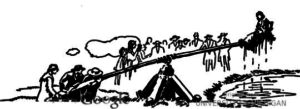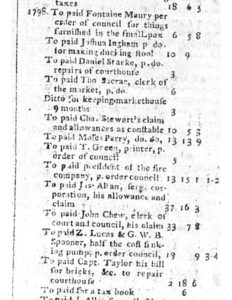Ducking Stools in Fredericksburg
Ducking Stools in Fredericksburg
By: Michael Spencer
Ducking stools, “an instrument of punishment for nags, gossips, witches, and difficult individuals”, often consisted of a “…chair suspended from a sweeplike pole” that would be lowered into water.[1] While used throughout Europe during the medieval period, it was also used here in Virginia until the 19th century.
Legislation passed in 1662 by the Virginia Assembly stated that “Whereas, many babbling women slander and scandalize their neighbors, for which their poor husbands are often involved in chargeable and vexatious suit, and case in great damage: Be it, therefore enacted by the authority aforesaid, that in actions of slander, occasioned by the wife, after judgement passed for the damages, the woman shall be punished by Ducking…”[2]
Mrs. Vivan Minor Fleming recounts, from an old resident, such a ducking in her book “Historic Period of Fredericksburg 1608-1861”,
“She saw Peggy, a noted termagant, as tied in a gig that had been improvised into a ducking stool, she was pushed along through the streets polluting the air with her foul oaths and surrounded by a clamorous crowd of men and boys. Dr. Edward Carmichael and Mr. William White, then small chaps, being not the lead vociferous. She was pushed along to the old baptizing place and into the river-the water over her head. Then they drew her out, but she was more vituperative than ever. Again they pushed her in and she came out sputtering anathemas, but the third submersion silenced her. She returned through the same streets, in the same gig, as quiet as a lamb.”[3]
Fredericksburg seems to have adopted ducking as a form of punishment fairly early and continued it for some time. The first reference to ducking in Fredericksburg was made in 1746 when Marquis Calmes, of Winchester, Virginia was paid £5:5 for erecting a “ducking stool according to the model of that of Fredericksburg.” The reference goes on to allude to the general configuration of the stool when describing the punishment of a prisoner, “…the culprit was tied to the end of a long plank working on a pivot”.[4]
A second mention of a ducking stool occurs in Fredericksburg Council minutes from 1795 with “Zachariah Lucas & James Brown” tasked with finding “some person” to build the device, obviously a replacement from the earlier one.[5] It appears that by 1799 they were successful with Joshua Ingham being paid £10:9 “for making a ducking stool.”[6] A third, and possibly final ducking stool, was made for Fredericksburg in 1822 by John Ferneyhough at a cost of $30.[7]
The location of the ducking stool, was at the “old baptism place” which both court records as well as Silvanus Quinn, in his 1908 “History of the City of Fredericksburg, Virginia”, note as being at the end of Wolfe Street adjacent to Thornton’s Tavern. This would have made sense as this was also the location of one of Fredericksburg’s early ferries and so would have had a water depth adequate to facilitate the ducking.

Figure 1: Image from Pioneer Pittsburgh, a 1937 publication showing a representation of a ducking stool. The actual configuration of the one at Fredericksburg may have been similar.

Virginia Herald, June 28, 1799 Reference to Ducking Stool.
___________________________________
[1] Lounsbury, Carl. An Illustrated Glossary of Early Southern Architecture and Landscape, pg. 124
[2] Norris, J.E., History of Lower Shenandoah Valley Counties.
[3] Fleming, Historic Period of Fredericksburg 1608-1861, pg. 25-26
[4] Morton, Frederic. The Story of Winchester.
[5] Fredericksburg City Council Minutes 1795, [transcribed by Gary Stanton]
[6] Virginia Herald, June 28, 1799, pg. 3 col. 3
[7] Fredericksburg City Council Minutes 1822, [transcribed by Gary Stanton]

Leave a Reply
Want to join the discussion?Feel free to contribute!